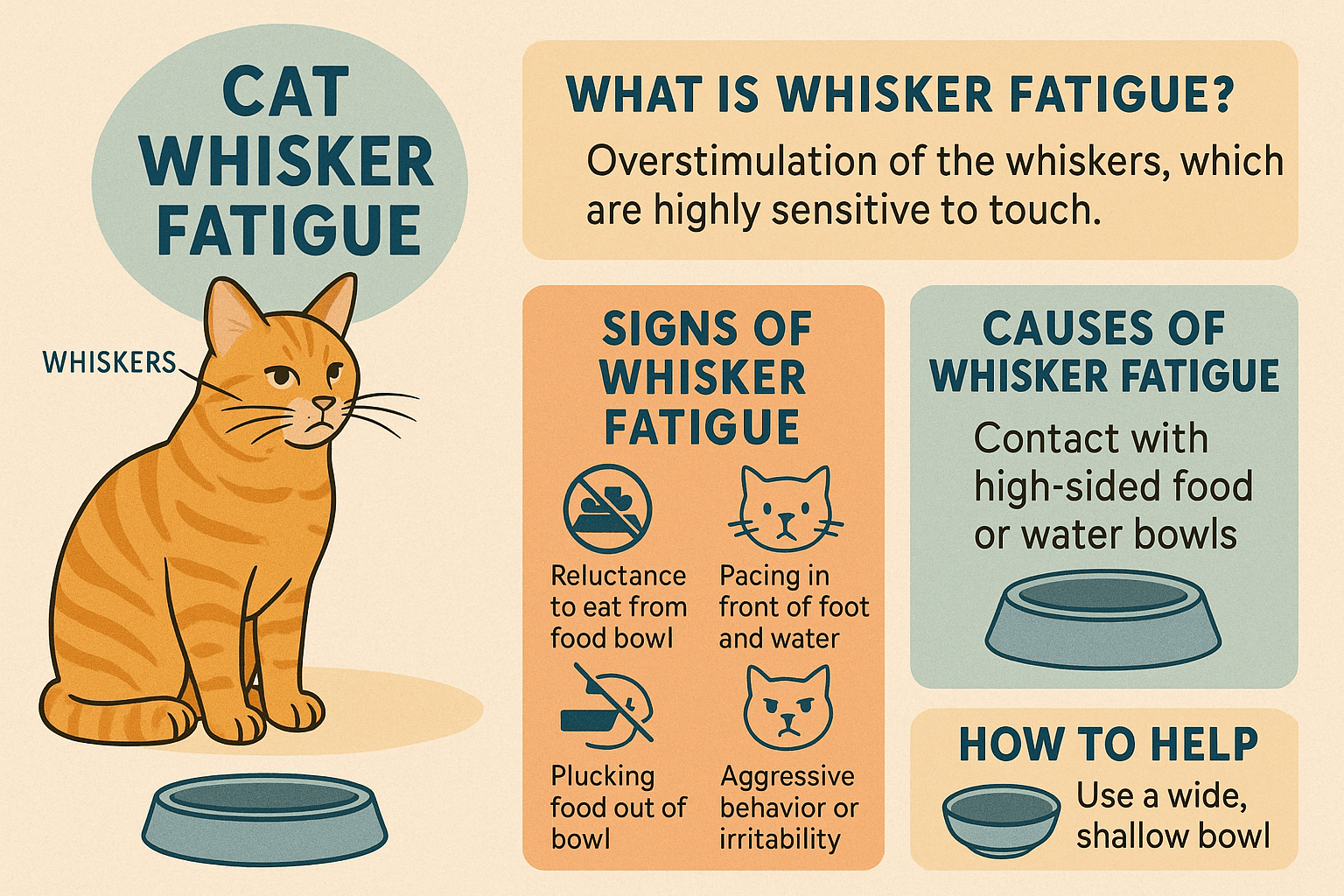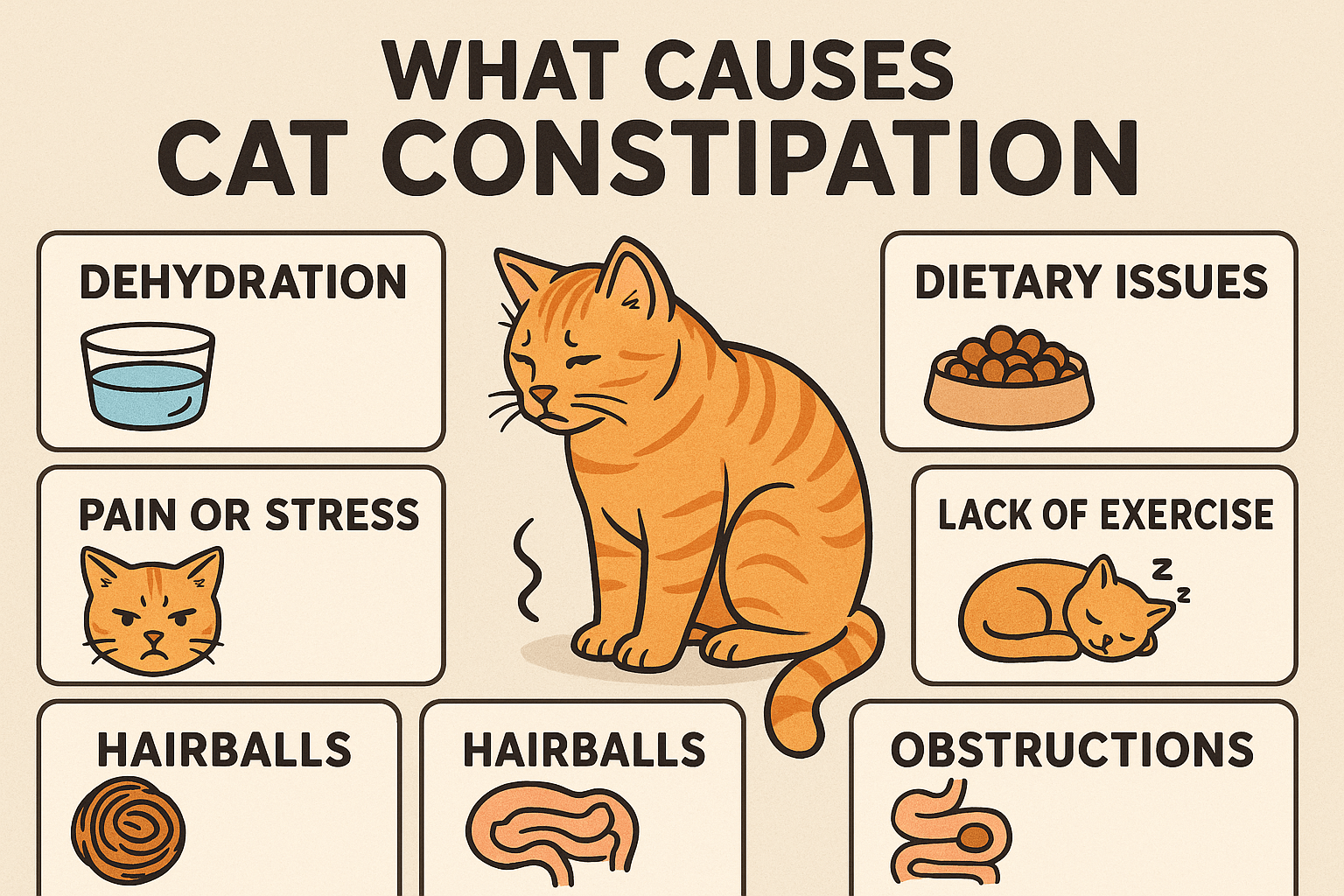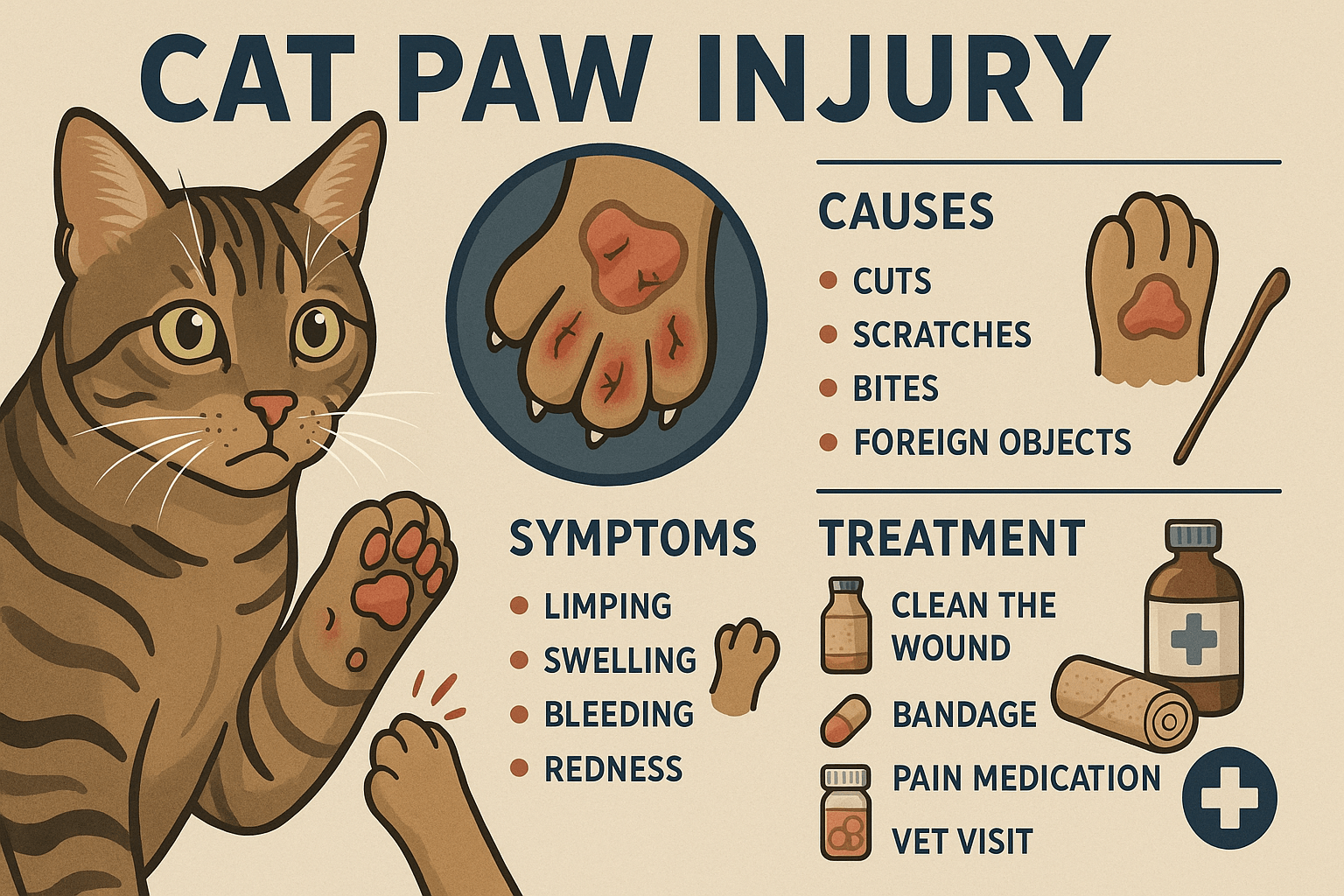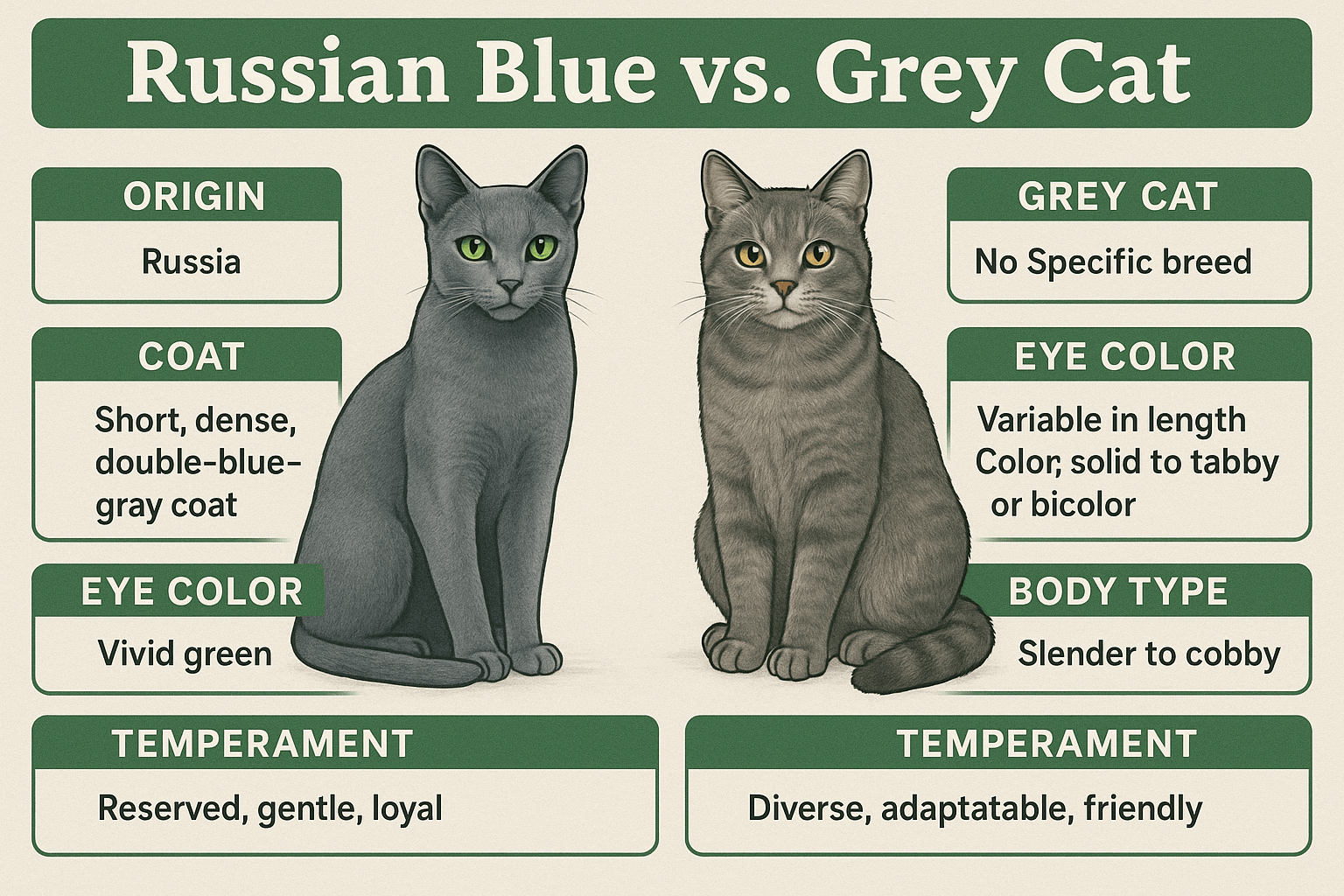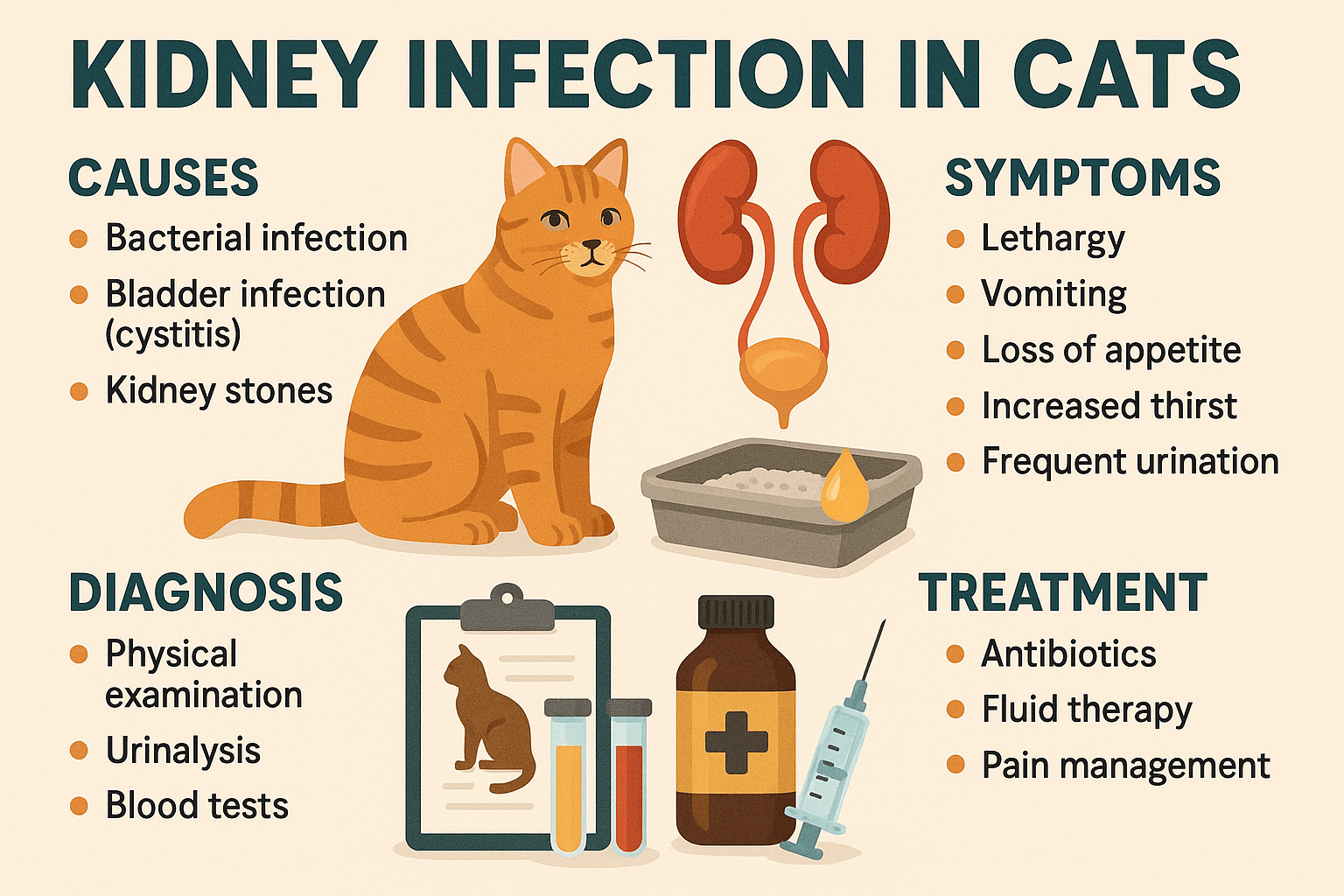Understanding Cat Whisker Fatigue
Cat whiskers are far more than just adorable facial features—they are highly sensitive tools that help felines navigate their environment. However, many cat owners are unaware of a condition known as “cat whisker fatigue,” which can affect their pet’s well-being. This phenomenon occurs when a cat’s whiskers become overstimulated or stressed due to excessive contact with objects like food bowls or narrow spaces. While not life-threatening, whisker fatigue can cause discomfort and behavioral changes in cats. In this blog post, we’ll explore what whisker fatigue is, how to recognize its signs, and practical ways to alleviate it for your feline friend.
What Causes Cat Whisker Fatigue?
Whisker fatigue isn’t caused by the whiskers themselves but by external factors that overwhelm their sensory functions. Understanding these causes can help you prevent and address the issue effectively.
Deep or Narrow Food Bowls:
When a cat eats from a deep or narrow bowl, their whiskers constantly touch the sides, leading to sensory overload.Frequent Contact with Objects:
Cats whose whiskers frequently brush against walls, furniture, or other surfaces may experience stress and irritation.Improper Water Bowl Design:
Similar to food bowls, water bowls that press against a cat’s whiskers can contribute to fatigue over time.Environmental Stressors:
Overcrowded spaces or environments with too much stimulation can exacerbate whisker sensitivity.Genetic Factors:
Some cats may naturally have more sensitive whiskers, making them prone to fatigue even with minimal contact.
By identifying these triggers, you can take steps to minimize whisker fatigue and ensure your cat remains comfortable and happy.
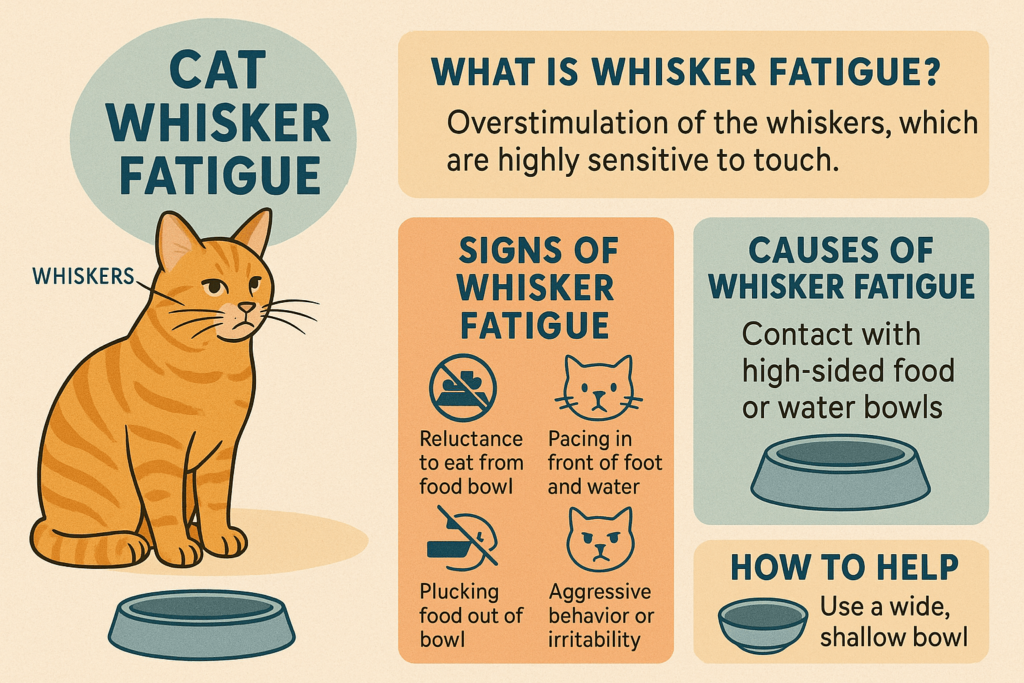
Signs Your Cat May Be Experiencing Whisker Fatigue
Recognizing the symptoms of whisker fatigue is crucial for addressing the issue early. Keep an eye out for these behavioral and physical signs that may indicate your cat is struggling.
Refusal to Eat or Drink:
If your cat avoids meals or seems hesitant to approach their food bowl, it could be a sign of discomfort caused by whisker fatigue.Pawing at Food Instead of Eating:
Cats may try to scoop food out of the bowl to avoid whisker contact, indicating sensitivity or stress.Increased Aggression Around Meals:
A normally calm cat might become irritable or defensive during feeding times due to discomfort.Licking Paws Excessively:
Over-grooming or excessive licking around the face can signal irritation related to whisker fatigue.Reluctance to Explore Tight Spaces:
Cats may avoid areas where they feel their whiskers will be pressed or stimulated, such as narrow passages or small boxes.
These signs should prompt you to evaluate your cat’s environment and make adjustments to reduce whisker-related stress.
Check this guide 👉Crimped Cat Whiskers: Best 7 Expert Tips!
Check this guide 👉Cat Whiskers Position Meaning: Best 7 Expert Tips!
Check this guide 👉Are You Supposed to Trim Cat Whiskers? Best 7 Tips!
Ways to Prevent Whisker Fatigue | Signs Your Cat Needs Help |
|---|---|
Use shallow, wide food and water bowls | Refusal to eat or drink |
Provide spacious feeding areas | Pawing at food instead of eating |
Avoid overcrowded environments | Increased aggression during meals |
Choose soft, flexible materials for toys | Excessive grooming around the face |
Monitor behavior for changes | Reluctance to enter tight spaces |
Practical Solutions for Reducing Whisker Fatigue
Fortunately, there are several easy and effective ways to alleviate whisker fatigue and improve your cat’s quality of life. Implementing these solutions can make a significant difference in their comfort.
Switch to Wide, Shallow Bowls:
Replace deep or narrow bowls with wider, shallower alternatives to prevent whisker contact while eating or drinking.Use Plates Instead of Bowls:
Serving food on flat plates eliminates the risk of whisker stimulation entirely.Provide Multiple Feeding Stations:
Offering multiple food and water stations reduces competition and stress in multi-cat households.Opt for Elevated Feeders:
Raised feeders allow cats to eat in a more natural posture, reducing strain on their whiskers.Choose Whisker-Friendly Toys:
Select soft, lightweight toys that won’t press against your cat’s whiskers during playtime.
With these simple adjustments, you can create a whisker-friendly environment that supports your cat’s overall well-being.
How to Support Your Cat’s Sensory Health
Beyond addressing whisker fatigue directly, supporting your cat’s sensory health can enhance their overall comfort and happiness. These tips focus on creating a balanced and enriching environment.
Minimize Environmental Noise:
Loud or sudden noises can overwhelm a cat’s sensitive senses, including their whiskers. Maintain a quiet, calm space for them to relax.Offer Safe Hiding Spots:
Provide cozy hiding spots where your cat can retreat if they feel overstimulated or stressed.Respect Personal Space:
Avoid forcing your cat into situations where their whiskers might be pressed or touched unnecessarily.Monitor Stress Levels:
Watch for signs of stress, such as changes in appetite or behavior, and address them promptly to prevent further issues.Regular Vet Check-Ups:
Schedule routine veterinary visits to rule out underlying health conditions that might mimic whisker fatigue symptoms.
By prioritizing your cat’s sensory needs, you can foster a harmonious and supportive living environment.
Common Myths About Cat Whiskers
There are many misconceptions about cat whiskers, which can lead to misunderstandings about whisker fatigue. Debunking these myths helps cat owners make informed decisions.
Myth: Whiskers Are Just Decorative Features:
In reality, whiskers are highly sensitive tactile hairs that help cats detect changes in their surroundings.Myth: Trimming Whiskers Won’t Harm Your Cat:
Trimming whiskers can leave your cat disoriented and unable to navigate properly.Myth: Whisker Fatigue Is a Myth Itself:
While not all cats experience it, whisker fatigue is a real condition that affects many felines.Myth: Only Older Cats Get Whisker Fatigue:
Cats of all ages can develop whisker fatigue depending on their environment and habits.Myth: Changing Bowls Won’t Make a Difference:
Switching to whisker-friendly bowls often alleviates symptoms and improves eating habits.
Dispelling these myths ensures you approach whisker care with accurate knowledge and empathy.
How to Transition to Whisker-Friendly Bowls
Transitioning to whisker-friendly bowls can be a game-changer for cats experiencing whisker fatigue. Follow these steps to make the switch seamless and stress-free.
Introduce Gradually:
Place the new bowl next to the old one and encourage your cat to explore it without pressure.Maintain Familiarity:
Use the same type of food or water initially to avoid overwhelming your cat with too many changes at once.Observe Reactions:
Watch how your cat interacts with the new bowl and adjust placement or design if needed.Reward Positive Behavior:
Offer treats or praise when your cat uses the new bowl to reinforce positive associations.Be Patient During the Adjustment Period:
Allow your cat time to adapt, especially if they’re hesitant or resistant at first.
A thoughtful transition ensures your cat embraces the change without added stress.
Fun Facts About Cat Whiskers
Cat whiskers are fascinating and serve purposes beyond what most people realize. Here are some intriguing facts about these remarkable sensory tools.
Whiskers Are Connected to Nerves:
Each whisker is deeply rooted in a follicle packed with nerves, making them incredibly sensitive to touch.Whiskers Can Detect Airflow Changes:
Cats use their whiskers to sense subtle shifts in air currents, helping them “see” in the dark.Whiskers Reflect Mood:
The position of a cat’s whiskers can indicate their emotional state—relaxed, alert, or agitated.Not All Whiskers Are on the Face:
Cats also have smaller whiskers above their eyes, on their chin, and near their wrists.Whiskers Shed Naturally:
Like fur, whiskers shed and regrow periodically, so finding a stray whisker isn’t cause for alarm.
Learning these fun facts deepens your appreciation for your cat’s incredible sensory abilities and reinforces the importance of protecting their whiskers.
Frequently Asked Questions About Cat Whisker Fatigue
What exactly is whisker fatigue?
Whisker fatigue occurs when a cat’s whiskers become overstimulated or stressed due to frequent contact with objects like food bowls.
Can whisker fatigue harm my cat?
While not physically harmful, it can cause discomfort and behavioral changes that affect your cat’s quality of life.
How do I know if my cat has whisker fatigue?
Signs include refusal to eat, pawing at food, excessive grooming, and avoiding tight spaces.
Are certain cats more prone to whisker fatigue?
Cats with longer or more sensitive whiskers may be more susceptible, but any cat can experience it under the right conditions.
Should I trim my cat’s whiskers to prevent fatigue?
No, trimming whiskers can disorient your cat, as they rely on them for navigation and sensory input.
Creating a Whisker-Friendly Environment for Your Cat
Cat whisker fatigue might seem like a minor issue, but it can significantly impact your feline friend’s comfort and behavior. By understanding the causes, recognizing the signs, and implementing practical solutions, you can create a supportive and stress-free environment for your cat. Simple changes, such as switching to shallow bowls or providing safe spaces, can make a world of difference. Remember, your cat’s whiskers are vital tools for exploring their world—ensuring they remain healthy and stress-free is key to fostering a happy and thriving companion.
What Causes Cat Constipation? Best 7 Expert Tips! Discover common causes, symptoms, and solutions for cat constipation to keep your feline healthy and comfortable.
Cat Paw Injury: Best 7 Expert Tips! Discover essential advice on identifying, treating, and preventing cat paw injuries to keep your feline friend healthy and happy.
Russian Blue vs Grey Cat: Best 7 Expert Tips! Discover key differences, unique traits, and expert advice to help you choose between a Russian Blue and a generic grey cat for your perfect feline companion.
Kidney Infection in Cats: Best 7 Expert Tips! Discover essential advice on recognizing symptoms, treatment options, and preventive care to keep your cat healthy and thriving.

